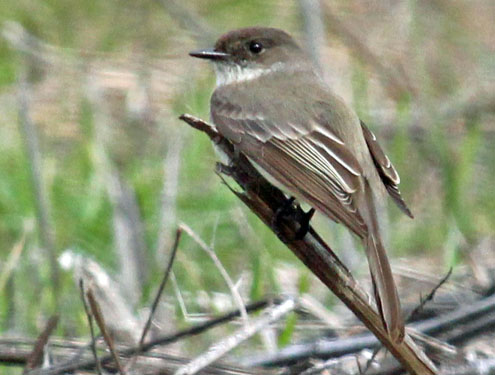These highlights chronicle the year 2021. The year runs generally
"backwards" on this page. In crediting records of vagrant or unusual birds, I always try to credit the finder(s) of the rarity. There will be times when complications arise with credit, e.g., one or more observers find a bird but others are the ones to actually identify it. There are times when a bird is properly identified only days later after photo review.
The abbreviation "MTY" means "Monterey County"
in the text below. Text by Don Roberson. Photos on this page
are copyrighted by the photographers to whom they are
attributed, and may not be reproduced in any form (including
other web sites) without the express consent of the photographer. |
| |
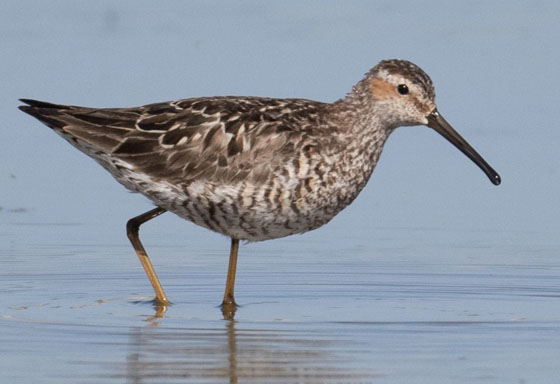 The final highlight of the first half of 2021 was reported on 31 May, when Brian Sullivan discovered an alternate-plumaged Stilt Sandpiper at a restricted access site near Salinas. This is the first-ever spring record from MTY, although it is certainly very late in spring migration! The bird was in nice breeding plumage (=alternate plumage; photo from 2 June, left, © Brian L. Sullivan). It proved to be present from 30 May-2 June. The final highlight of the first half of 2021 was reported on 31 May, when Brian Sullivan discovered an alternate-plumaged Stilt Sandpiper at a restricted access site near Salinas. This is the first-ever spring record from MTY, although it is certainly very late in spring migration! The bird was in nice breeding plumage (=alternate plumage; photo from 2 June, left, © Brian L. Sullivan). It proved to be present from 30 May-2 June.
Locally, we might average about one Stilt Sandpiper annually, but nearly all of them have been juvs in fall migration, and just a handful in basic plumage in late fall or early winter. The only other Stilt Sandpiper in alternate plumage was an adult at Castroville on 4 July 1994 (S.F. Bailey, D. Roberson, R. Carratello).
The other late May shorebird vies with the Rusty Blackbird (below) for the best bird of 2021 so far. On 29 May, newly-arrived MTY resident, but long-time Bay Area birder, Steve Tucker, discovered an alternate-plumage White-rumped Sandpiper at a restricted site in the lower Salinas Valley (two photos below, © Steve Tucker). This is a major rarity anywhere in California, yet over half of the State's records have been very late spring vagrants in late May or early June.
California has had less than 25 White-rumped Sandpipers ever, but MTY has four them now: two in spring and two in fall. The other spring bird was at the Carmel River mouth from 2-7 June 1978 (found by Jeri Langham). The two fall birds were at the Salinas WTP, back when those were active, and both were adults heading south in fall: 14-15 Sep 1985 (found by S.N.G. Howell; also seen 18 Sep 1985 at Salinas R. m. by P.J. Metropulos), and from 1-9 2007 (found by B.L. Sullivan, and seen by many). Unfortunately, this year's White-rumped was never refound after it was discovered and documented. |
|
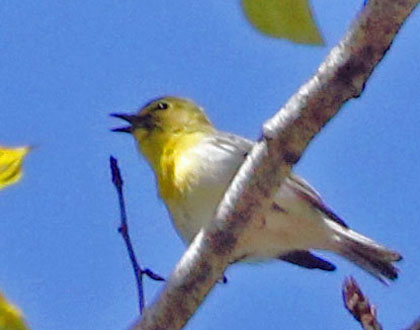 Typically in late May or early June, MTY birders locate a few "eastern" landbird rarities at "vagrant traps" along the coast. This was not a typical year. Spring was unseasonably cold and had many more foggy or windy days than were expected. Many of our usual western migrants and local breeders arrived late. With just a few exceptions, landbird rarities were few. A singing Northern Parula at A. Molera SP on 14 May (T. Amaral et al.), and a female Rose-breasted Grosbeak at a feeder near Pt. Lobos 2-4 June (John Hiles), were just about it. By far the rarest "eastern" vagrant in late May was a singing Yellow-throated Vireo at Rancho Cañada, Palo Corona Reg. Park, on 30 May (Don Roberson, Rita Carratello; photo © D. Roberson, left). This is the 12th MTY record. Typically in late May or early June, MTY birders locate a few "eastern" landbird rarities at "vagrant traps" along the coast. This was not a typical year. Spring was unseasonably cold and had many more foggy or windy days than were expected. Many of our usual western migrants and local breeders arrived late. With just a few exceptions, landbird rarities were few. A singing Northern Parula at A. Molera SP on 14 May (T. Amaral et al.), and a female Rose-breasted Grosbeak at a feeder near Pt. Lobos 2-4 June (John Hiles), were just about it. By far the rarest "eastern" vagrant in late May was a singing Yellow-throated Vireo at Rancho Cañada, Palo Corona Reg. Park, on 30 May (Don Roberson, Rita Carratello; photo © D. Roberson, left). This is the 12th MTY record.
Somewhat ironically, this year's Yellow-throated Vireo was singing high atop large cottonwoods in the old golf course at Rancho Cañada. These same cottonwoods hosted two different singing Yellow-throated Vireos back in late May-early June 2017 (both found by Michael Rieser). Unfortunately, unlike 2017, this year's Yellow-throated Vireo was not refound the next week, although people looking for it re-discovered the lingering Vermilion Flycatcher (see below) at Rancho Cañada. |
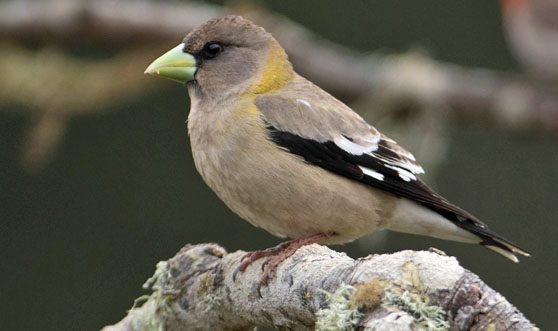 There was a mild influx of Red Crossbills this last winter, all "type 2" (Ponderosa Pine types) — and a few lingered locally into May — but only a trifling flight of Evening Grosbeak. Yet a female Evening Grosbeak put in an unexpected May appearance at John Hiles' feeder in the Pt. Lobos vicinity from 11-14 May (photo 12 May, right, © John Hiles). This is quite late for this species to be in MTY. There was a mild influx of Red Crossbills this last winter, all "type 2" (Ponderosa Pine types) — and a few lingered locally into May — but only a trifling flight of Evening Grosbeak. Yet a female Evening Grosbeak put in an unexpected May appearance at John Hiles' feeder in the Pt. Lobos vicinity from 11-14 May (photo 12 May, right, © John Hiles). This is quite late for this species to be in MTY.
Bill Hubick was able to record its call, and had it analyzed by an expert in Evening Grosbeak vocalizations. It was "type 1."
Type 1 is the most widespread type in the West, from the northern Rockies and the Cascades to at least British Columbia and south to Oregon and the Black Hills of South Dakota. These grosbeaks occasionally wander south to the northern Sierra Nevada and beyond. This type apparently does not nest in California; the Sierra Nevada breeders are "type 2." |
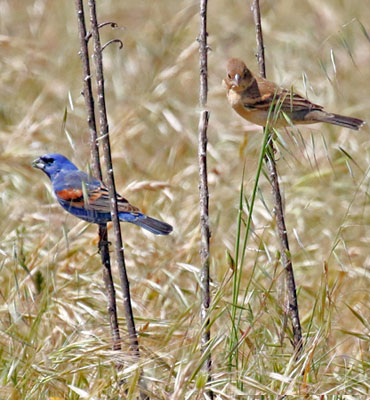 |
Last year's pair of Blue Grosbeak returned to Ft. Ord NM in May (male on 2 May, pair by 5 May; photo 7 May, left, © D. Roberson). We don't know if last year's nest attempt succeeded, but hopefully they will try again. This is the northernmost pair in MTY.
A Pacific Loon appeared on Laguna Grande on 24 May (Rita Carratello; photo right 25 May, © D. Roberson). While common on the sea, it is very rare on freshwater. It was probably oiled, as it came ashore once to preen. It lingered into June. |
 |
|
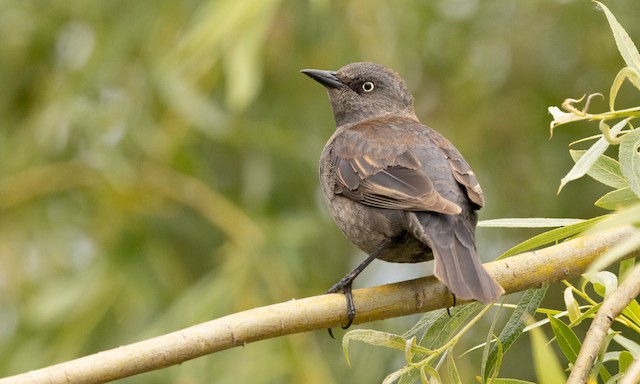 In early May, Paul Fenwick found the rarest MTY bird to this point in 2021. In the main parking lot for Lake El Estero in downtown Monterey, he photographed this Rusty Blackbird (right; © Paul Fenwick). This eastern and northern icterid is a major rarity in California. Nearly all have been in October-November, with a few wintering. Spring records from late March to late April are very few indeed. This MTY individual appears to be the first ever in May in all of California (CBRC 2007). Word spread quickly and many locals got to view this excellent rarity on 7 May. It was documented only that one day, and many got good photos. In early May, Paul Fenwick found the rarest MTY bird to this point in 2021. In the main parking lot for Lake El Estero in downtown Monterey, he photographed this Rusty Blackbird (right; © Paul Fenwick). This eastern and northern icterid is a major rarity in California. Nearly all have been in October-November, with a few wintering. Spring records from late March to late April are very few indeed. This MTY individual appears to be the first ever in May in all of California (CBRC 2007). Word spread quickly and many locals got to view this excellent rarity on 7 May. It was documented only that one day, and many got good photos.
Rusty Blackbird populations have been in serious declines in recent decades. The CBRC put it back on their review list in 2006.There had been only ten previous records in MTY — all between October to February — and only two this century: one in San Carlos cemetery at Lake El Estero (27-28 Oct 2013) and one at Moonglow Dairy (13 Jan-18 Feb 2018).
|
 For many of us who grew up in the West, this was the first time ever to see a spring-plumaged Rusty Blackbird. In fall and winter, most Rustys have extensive rusty coloration on the head and back (see the Oct 2013 bird halfway down that seasonal page). Breeding plumage is obtained as the reddish edges wear off to create a shiny black male or a slate-gray female. The presence of this vagrant among Brewer's & Red-winged Blackbirds and Brown-headed Cowbirds permitted us to compare features. Here (left) is a collage from photos of the Rusty Blackbird and a male Brewer's Blackbird nearby [I placed the birds side-by-side by combining two photos; © D. Roberson]. We can compare bill shape and tail length. For many of us who grew up in the West, this was the first time ever to see a spring-plumaged Rusty Blackbird. In fall and winter, most Rustys have extensive rusty coloration on the head and back (see the Oct 2013 bird halfway down that seasonal page). Breeding plumage is obtained as the reddish edges wear off to create a shiny black male or a slate-gray female. The presence of this vagrant among Brewer's & Red-winged Blackbirds and Brown-headed Cowbirds permitted us to compare features. Here (left) is a collage from photos of the Rusty Blackbird and a male Brewer's Blackbird nearby [I placed the birds side-by-side by combining two photos; © D. Roberson]. We can compare bill shape and tail length.
The literature says Rusty Blackbird has a slimmer, more evenly proportioned bill and a shorter tail and legs than Brewer's. I think we can see some of those characters in this collage. More importantly, the Rusty has rusty edges to the tertials and greater coverts. There are times, particularly in autumn, when some Brewer's have reddish edges to the back or head that creates an i.d. problem. The location and color of these edges (Brewer's are browner and shorter) is a key to identification in those difficult birds (see Musher et al. 2017). Bill shape or tail length are additional characters.
|
Other fine birds found in April 2021 included a Gray Flycatcher photographed by Kent Van Vuren on 30 Apr (another one-day-wonder), a scarce Least Tern photographed on Elkhorn Slough on 22 Apr (Roger Lambert), and two observations of Pileated Woodpeckers (alas, without photos): one was on a private ranch in Rooster Canyon in the Diablo Range, on 3 Apr (Robert Keiffer), and another was described in flight at Pt. Pinos on 11 Apr by a visiting birder (Samuel Holman) who was familiar with the species as the eBird editor for Klikitat County, Washington. These are now among six records of this rarity that have appeared in April or May since 2015. This great woodpecker breeds in Santa Cruz Co., and presumably those here in MTY are spring dispersals from an expanding population there.
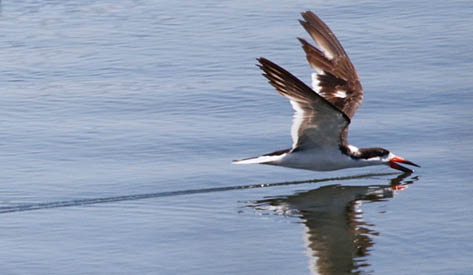 Both Least Tern and Black Skimmer have small breeding populations in San Francisco Bay. Presumably these populations migrate up and down the coast of MTY during spring and fall migration, but birders find only a handful as they fly through MTY. This year we've had a smattering of Black Skimmer sightings from late March to early May. On 8 May five skimmers were together in the north harbor at Moss Landing, both roosting and foraging for food. The roosting skimmers sat among 17 Red Knot (quite a high count these days; Bill Hubick). We were lucky to aim a camera at a skimming skimmer (right, 8 May, © D. Roberson). Both Least Tern and Black Skimmer have small breeding populations in San Francisco Bay. Presumably these populations migrate up and down the coast of MTY during spring and fall migration, but birders find only a handful as they fly through MTY. This year we've had a smattering of Black Skimmer sightings from late March to early May. On 8 May five skimmers were together in the north harbor at Moss Landing, both roosting and foraging for food. The roosting skimmers sat among 17 Red Knot (quite a high count these days; Bill Hubick). We were lucky to aim a camera at a skimming skimmer (right, 8 May, © D. Roberson).
Several rare wintering birds remained into April: the Tropical Kingbird in its second winter at Laguna Grande was present to 9 April, and another found in January at Carr Lake, Salinas, was apparently still present on 8 May (Mike Stake). Last year the Laguna Grande kingbird set the all-time late date of 29 Apr 2020 but this year's date breaks that record. At Locke-Paddon Park in Marina, a Northern Waterthrush that arrived on 30 Oct wintered, and was last reported on 28 Apr (Kent Van Vuren). In Pacific Grove, "Verano" or "Old Red," the adult Summer Tanager, made it through its 8th winter locally; it was last reported on 7 Apr 2021 (Blake Matheson).
Also in Pacific Grove, on 30 March, a Black-and-white Warbler bathed in Rita Carratello's backyard birdbath. This was not a known wintering bird so perhaps it was an early migrant? |
The Atlas of the Breeding Birds of Monterey County documented 173 species of native birds breeding in MTY from 1988–1992, plus another 7 "possible" breeders (Roberson & Tenney 1993). The numbers of breeding species is always variable, if one considers extirpated breeders from the distant past — e.g., Swainson's Hawk, Clapper Rail, Bell's Vireo — and those from the recent past, e.g., Flammulated Owl, Mountain Chickadee. We've added new breeding birds in recent years as well, including Heermann's and California Gulls, Eared Grebe, Redhead, and (very likely) Cedar Waxwing. Plus some wayward vagrants have occasional nested successfully — Northern Parula, Indigo Bunting, Hooded Warbler — and others have tried and failed (Black Skimmer). Yet, among the nearly 200 birds that have tried to breed locally, a prominent species was always missing: Osprey. This always seemed surprising since Osprey nest in Santa Cruz Co., just to the north. We've been seeing more juvenal Ospreys in mid-summer recently that "might" have been from local nests, but actual evidence was missing: until now.
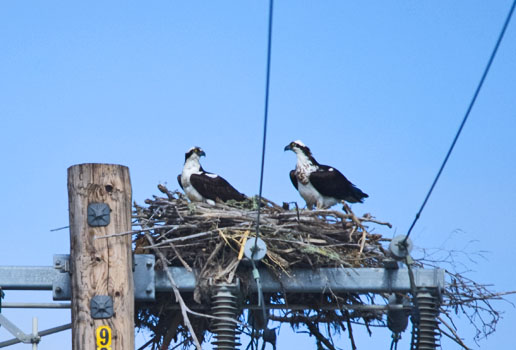 On 1 April, Marcos Rangel discovered a pair of Osprey on a nest near Castroville (photo left 1 Apr, © Marcos Rangel). At that date it appeared the nest was nearing completion of construction, with sticks still being delivered. By 3 Apr, one Osprey (presumably the female) was sitting on the nest, possibly on eggs, with the presumed male perched nearby (R. Carratello, D. Roberson). Visits in April and early May found the (presumed) female on the nest, but by 8 May she seemed edgy, as if the chicks might be near hatching. Assuming eggs were laid about 3 April, the incubation period should end ~5-18 May. Then, for another 48-59 days, at which time the young fledge, the male brings food to the nest and the female feeds the young (Ehrlich et al. 1988). Perhaps we'll have one or more successfully fledged young by mid-July? On 1 April, Marcos Rangel discovered a pair of Osprey on a nest near Castroville (photo left 1 Apr, © Marcos Rangel). At that date it appeared the nest was nearing completion of construction, with sticks still being delivered. By 3 Apr, one Osprey (presumably the female) was sitting on the nest, possibly on eggs, with the presumed male perched nearby (R. Carratello, D. Roberson). Visits in April and early May found the (presumed) female on the nest, but by 8 May she seemed edgy, as if the chicks might be near hatching. Assuming eggs were laid about 3 April, the incubation period should end ~5-18 May. Then, for another 48-59 days, at which time the young fledge, the male brings food to the nest and the female feeds the young (Ehrlich et al. 1988). Perhaps we'll have one or more successfully fledged young by mid-July?
UPDATE: Both adults were at the nest on 29 May and the presumed male appeared to be regurgitating food to a nestling (D. Roberson, R. Carratello). Although we could not see the chick, this was the first firm evidence that at least one egg had hatched.
UPDATE: We checked the nest mid-day on Sunday, 13 June. It appeared to be abandoned. Neither adult was in view anywhere. We hope the birds were were not shot at or harassed. Perhaps the distance to water and food was too great? Perhaps the male could not bring enough fish to the nestling to survive? It looks grim at this point. At least this was the very first proven nesting attempt in MTY. |
|
| On 26 March, Pt. Lobos docents Richard & Ann Pettit, visiting Palo Corona Regional Park, discovered this male Vermilion Flycatcher (below; these two photos at different spots in the Rancho Cañada portion of Palo Corona on 26 March; left © Carole Rose, and right, © D. Roberson). You may recall from prior updates that a male Vermilion was along the Rancho Cañada western fenceline from 17-25 June 2019, and again from 2 July-1 Sep 2020. It moved around a bit during those first two visits, and we guess that this male is the same bird returning. Yet it ranged farther in 2021 and spent much less time around the fenceline. After being missed for a weeks, it was refound in late May and is still present into June 2021. |
|
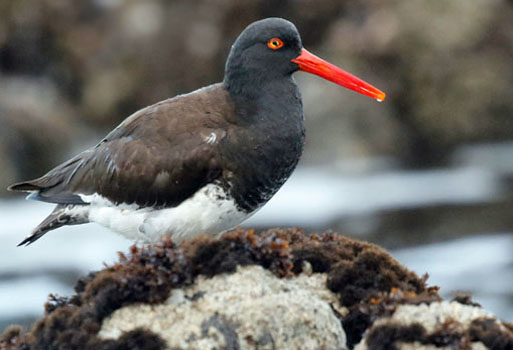 The excitement in late February and early March was the presence of a pied-patterned oystercatcher among Black Oystercatchers. First discovered at Yankee Pt. by resident Bonnie Burgess, it stayed at that location from 27 Feb-3 March. Then, from 10-19 March, it visited various spots in Pacific Grove, from Pt. Pinos to Asilomar SB (photo, right, from Pt. Pinos 10 Mar, © D. Roberson). The excitement in late February and early March was the presence of a pied-patterned oystercatcher among Black Oystercatchers. First discovered at Yankee Pt. by resident Bonnie Burgess, it stayed at that location from 27 Feb-3 March. Then, from 10-19 March, it visited various spots in Pacific Grove, from Pt. Pinos to Asilomar SB (photo, right, from Pt. Pinos 10 Mar, © D. Roberson).
The general consensus of those consulted consider it to be a hybrid Black x American Oystercatcher, based primarily on a "hybrid index" in Jehl (1985). A minority challenged those underlying assumptions, noting that Jehl (1985) found hybridization in Baja California to be rare. The CBRC's use of the index has labeled the majority of pied birds in California as hybrids (CBRC 2007), inconsistent with Jehl's analysis. The alternative is that this bird represents just one plumage state within the known cline of plumage states within frazari American Oystercatchers from west Mexico; see a much longer discussion on-line. Whatever your opinion, it was a very striking oystercatcher on the MTY coast.
Claims of "American Oystercatcher" at Pt. Lobos in Apr 1954 and Apr 1955 do not have documentation, but could have been correct. An American Oystercatcher record from Avila Beach, San Luis Obispo Co., in Oct 1964-Mar 1965, just south of MTY, and one at San Francisco, in Apr 2011, north of MTY, have been accepted as the northernmost records in the state (e.g., CBRC 20007).
|
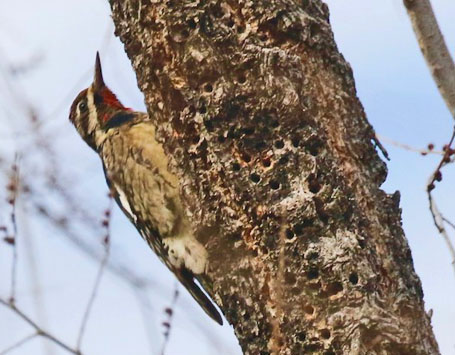 Highlights posted from December 2020 included the presence of at least five different Yellow-bellied Sapsuckers. One of those, at Lagunita Mirada, City of Monterey, wintered locally and was last reported on 23 Mar 2021. Highlights posted from December 2020 included the presence of at least five different Yellow-bellied Sapsuckers. One of those, at Lagunita Mirada, City of Monterey, wintered locally and was last reported on 23 Mar 2021.
To those five we can add two more, for an unprecedented total of seven different Yellow-bellied Sapsuckers in winter 2020-21. A juv male found by Rita Carratello at Little Peachtree Valley, far to the southeast in MTY, on 31 Jan 2021 (photo left, © D. Roberson) was presumably the same bird, now in full adult male plumage, on 9 March (Alex Rinkert, Mark Kudrav). Also present of 31 Jan were 6 Red-breasted Sapsuckers and a hybrid. Remarkably, a male Red-naped Sapsucker had been located at the same site on 30 Jan (Bill Hubick). Sapsucker city!
Yet another juv male Yellow-bellied Sapsucker was found by Eliana Heiser in Laguna Grande Park, Seaside, on 24 Mar 2021 — just the second record for that eBird hot spot. That's seven Yellow-bellied and one Red-naped in winter 2020-21, more than ever before. |
Our long Covid-year 2020 concluded with an Eastern Phoebe along the Carmel River, just upstream from the Highway 1 bridge, discovered by Bill Hill on 28 Dec. We typically average about one Eastern Phoebe each winter, yet two more would be discovered later that winter. Oddly, both were found on or near the lower Carmel River, but comparison of photos ruled each one to be a different individual. Thus, three vagrant phoebes within a 5-mile stretch of the lower Carmel River — a phenomenal winter. Eastern Phoebe #2 was at Palo Corona Reg. Park, found by Rita Carratello and her adult-education birding class on 8 Feb (photo below left 8 Feb, © Rita Carratello). This individual sported an injured leg, and tended to sit on wires or fences through its stay that ended 28 Feb. Eastern Phoebe #3 was found the Mark Kudrav at the Paso Hondo access to an upstream portion of Garland Ranch Reg. Park. at Dampiere Park on 18 Mar; it remained to 22 Mar (photo below right 20 Mar, © D. Roberson) |
|
| |
Literature cited:
- California Bird Records Committee (R.A. Hamilton, M.A. Patten, and R.A. Erickson, eds). 2007. Rare Birds of California. West. Field Ornith., Camarillo, CA.
- Ehrlich, P.R., D.S. Dobkin, and D. Wheye. 1988. The Birder's Handbook. Simon & Schuster, New York.
- Jehl, J.R., Jr. 1985. Hybridization and evolution of oystercatchers on the Pacific Coast of Baja California. Ornith. Monogr. No. 36.
- Musher, L, P. Pyle, D. Irons, and J. Tietz, James. 2017. Identification of male Euphagus blackbirds in fresh fall plumages. Western Birds 48: 205–210.
- Roberson, D. 2002. Monterey Birds, 2d ed. Monterey Audubon Soc., Carmel, CA.
- Roberson, D., and C. Tenney, ed. 1993. Atlas of the Breeding Birds of Monterey County, California. Monterey Audubon Soc., Carmel, CA.
|
|
TOP
GO TO
HOME PAGE
TO MONTEREY
COUNTY
PAGE
TO BIRD
FAMILIES
OF THE WORLD
|
 The final highlight of the first half of 2021 was reported on 31 May, when Brian Sullivan discovered an alternate-plumaged Stilt Sandpiper at a restricted access site near Salinas. This is the first-ever spring record from MTY, although it is certainly very late in spring migration! The bird was in nice breeding plumage (=alternate plumage; photo from 2 June, left, © Brian L. Sullivan). It proved to be present from 30 May-2 June.
The final highlight of the first half of 2021 was reported on 31 May, when Brian Sullivan discovered an alternate-plumaged Stilt Sandpiper at a restricted access site near Salinas. This is the first-ever spring record from MTY, although it is certainly very late in spring migration! The bird was in nice breeding plumage (=alternate plumage; photo from 2 June, left, © Brian L. Sullivan). It proved to be present from 30 May-2 June.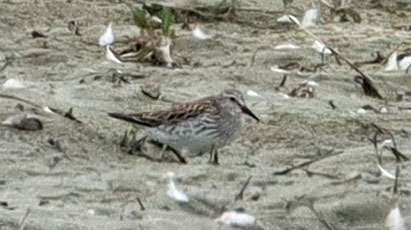
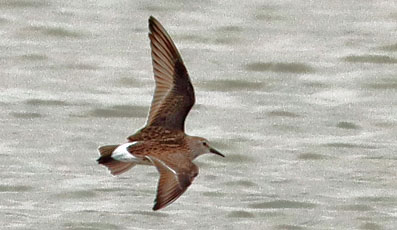
 Typically in late May or early June, MTY birders locate a few "eastern" landbird rarities at "vagrant traps" along the coast. This was not a typical year. Spring was unseasonably cold and had many more foggy or windy days than were expected. Many of our usual western migrants and local breeders arrived late. With just a few exceptions, landbird rarities were few. A singing Northern Parula at A. Molera SP on 14 May (T. Amaral et al.), and a female Rose-breasted Grosbeak at a feeder near Pt. Lobos 2-4 June (John Hiles), were just about it. By far the rarest "eastern" vagrant in late May was a singing Yellow-throated Vireo at Rancho Cañada, Palo Corona Reg. Park, on 30 May (Don Roberson, Rita Carratello; photo © D. Roberson, left). This is the 12th MTY record.
Typically in late May or early June, MTY birders locate a few "eastern" landbird rarities at "vagrant traps" along the coast. This was not a typical year. Spring was unseasonably cold and had many more foggy or windy days than were expected. Many of our usual western migrants and local breeders arrived late. With just a few exceptions, landbird rarities were few. A singing Northern Parula at A. Molera SP on 14 May (T. Amaral et al.), and a female Rose-breasted Grosbeak at a feeder near Pt. Lobos 2-4 June (John Hiles), were just about it. By far the rarest "eastern" vagrant in late May was a singing Yellow-throated Vireo at Rancho Cañada, Palo Corona Reg. Park, on 30 May (Don Roberson, Rita Carratello; photo © D. Roberson, left). This is the 12th MTY record. There was a mild influx of Red Crossbills this last winter, all "type 2" (Ponderosa Pine types) — and a few lingered locally into May — but only a trifling flight of Evening Grosbeak. Yet a female Evening Grosbeak put in an unexpected May appearance at John Hiles' feeder in the Pt. Lobos vicinity from 11-14 May (photo 12 May, right, © John Hiles). This is quite late for this species to be in MTY.
There was a mild influx of Red Crossbills this last winter, all "type 2" (Ponderosa Pine types) — and a few lingered locally into May — but only a trifling flight of Evening Grosbeak. Yet a female Evening Grosbeak put in an unexpected May appearance at John Hiles' feeder in the Pt. Lobos vicinity from 11-14 May (photo 12 May, right, © John Hiles). This is quite late for this species to be in MTY.

 In early May, Paul Fenwick found the rarest MTY bird to this point in 2021. In the main parking lot for Lake El Estero in downtown Monterey, he photographed this Rusty Blackbird (right; © Paul Fenwick). This eastern and northern icterid is a major rarity in California. Nearly all have been in October-November, with a few wintering. Spring records from late March to late April are very few indeed. This MTY individual appears to be the first ever in May in all of California (CBRC 2007). Word spread quickly and many locals got to view this excellent rarity on 7 May. It was documented only that one day, and many got good photos.
In early May, Paul Fenwick found the rarest MTY bird to this point in 2021. In the main parking lot for Lake El Estero in downtown Monterey, he photographed this Rusty Blackbird (right; © Paul Fenwick). This eastern and northern icterid is a major rarity in California. Nearly all have been in October-November, with a few wintering. Spring records from late March to late April are very few indeed. This MTY individual appears to be the first ever in May in all of California (CBRC 2007). Word spread quickly and many locals got to view this excellent rarity on 7 May. It was documented only that one day, and many got good photos. For many of us who grew up in the West, this was the first time ever to see a spring-plumaged Rusty Blackbird. In fall and winter, most Rustys have extensive rusty coloration on the head and back (see the Oct 2013 bird
For many of us who grew up in the West, this was the first time ever to see a spring-plumaged Rusty Blackbird. In fall and winter, most Rustys have extensive rusty coloration on the head and back (see the Oct 2013 bird  Both Least Tern and Black Skimmer have small breeding populations in San Francisco Bay. Presumably these populations migrate up and down the coast of MTY during spring and fall migration, but birders find only a handful as they fly through MTY. This year we've had a smattering of Black Skimmer sightings from late March to early May. On 8 May five skimmers were together in the north harbor at Moss Landing, both roosting and foraging for food. The roosting skimmers sat among 17 Red Knot (quite a high count these days; Bill Hubick). We were lucky to aim a camera at a skimming skimmer (right, 8 May, © D. Roberson).
Both Least Tern and Black Skimmer have small breeding populations in San Francisco Bay. Presumably these populations migrate up and down the coast of MTY during spring and fall migration, but birders find only a handful as they fly through MTY. This year we've had a smattering of Black Skimmer sightings from late March to early May. On 8 May five skimmers were together in the north harbor at Moss Landing, both roosting and foraging for food. The roosting skimmers sat among 17 Red Knot (quite a high count these days; Bill Hubick). We were lucky to aim a camera at a skimming skimmer (right, 8 May, © D. Roberson). On 1 April, Marcos Rangel discovered a pair of Osprey on a nest near Castroville (photo left 1 Apr, © Marcos Rangel). At that date it appeared the nest was nearing completion of construction, with sticks still being delivered. By 3 Apr, one Osprey (presumably the female) was sitting on the nest, possibly on eggs, with the presumed male perched nearby (R. Carratello, D. Roberson). Visits in April and early May found the (presumed) female on the nest, but by 8 May she seemed edgy, as if the chicks might be near hatching. Assuming eggs were laid about 3 April, the incubation period should end ~5-18 May. Then, for another 48-59 days, at which time the young fledge, the male brings food to the nest and the female feeds the young (Ehrlich et al. 1988). Perhaps we'll have one or more successfully fledged young by mid-July?
On 1 April, Marcos Rangel discovered a pair of Osprey on a nest near Castroville (photo left 1 Apr, © Marcos Rangel). At that date it appeared the nest was nearing completion of construction, with sticks still being delivered. By 3 Apr, one Osprey (presumably the female) was sitting on the nest, possibly on eggs, with the presumed male perched nearby (R. Carratello, D. Roberson). Visits in April and early May found the (presumed) female on the nest, but by 8 May she seemed edgy, as if the chicks might be near hatching. Assuming eggs were laid about 3 April, the incubation period should end ~5-18 May. Then, for another 48-59 days, at which time the young fledge, the male brings food to the nest and the female feeds the young (Ehrlich et al. 1988). Perhaps we'll have one or more successfully fledged young by mid-July?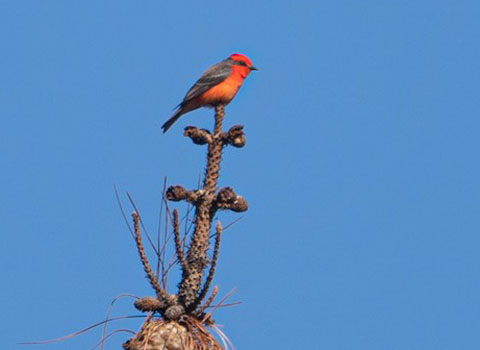
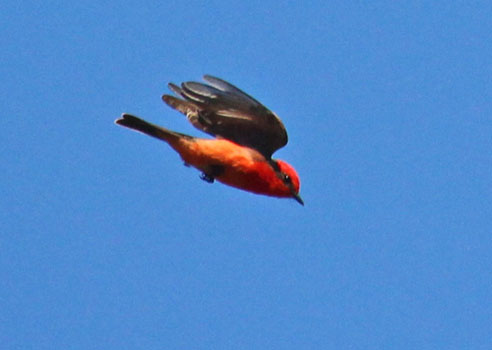
 The excitement in late February and early March was the presence of a pied-patterned oystercatcher among Black Oystercatchers. First discovered at Yankee Pt. by resident Bonnie Burgess, it stayed at that location from 27 Feb-3 March. Then, from 10-19 March, it visited various spots in Pacific Grove, from Pt. Pinos to Asilomar SB (photo, right, from Pt. Pinos 10 Mar, © D. Roberson).
The excitement in late February and early March was the presence of a pied-patterned oystercatcher among Black Oystercatchers. First discovered at Yankee Pt. by resident Bonnie Burgess, it stayed at that location from 27 Feb-3 March. Then, from 10-19 March, it visited various spots in Pacific Grove, from Pt. Pinos to Asilomar SB (photo, right, from Pt. Pinos 10 Mar, © D. Roberson). Highlights posted
Highlights posted 